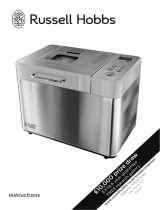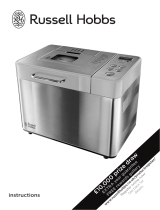
Compact Automatic Bread Maker
QUICK REFERENCE GUIDE
BEFORE USING YOUR BREAD MAKER FOR THE FIRST TIME
• Remove all packaging and any promotional labels or stickers from your bread maker.
• Be sure that all parts of your new bread maker have been unpacked before discarding
any packing materials. (Refer to page 3 of your Instruction Booklet for list of parts.)
• You may want to keep the box and packing materials for use at a later date.
• Wipe housing with a damp cloth to remove any dust from the warehouse or shipping.
• Wash kneading paddle and bread pan with sponge or damp cloth.
3.
2.
TO REMOVE BREAD PAN
from unit,
lift the handle and turn pan counterclockwise.
TO INSERT BREAD PAN,
lower pan
into unit and turn clockwise.
TO ATTACH KNEADING PADDLE,
insert onto shaft with wide base facing down.
1.
ASSEMBLY
Question Answer
Why did my dough/
bread not rise well?
There are a number of factors that could result in a short rise. Be sure that the
yeast is fresh and that all ingredients are at room temperature (75ºF to 90°F). If the
liquids are too warm or too cold, they will not activate the yeast properly. Be sure
the ingredients are put into the baking pan in the correct order. The salt should be
as far away from the yeast as possible. Note that not all breads rise as much as
others. Whole-wheat or whole-grain breads tend to be shorter than white breads.
Also, breads with more sugar or sweeteners, and ones that are enriched with
eggs, will be taller than regular white breads.
Why is my bread
sunken/uneven on
the top?
Humidity and room temperature can greatly affect the results of baked yeast
breads. Keep the bread maker away from direct sunlight. If the humidity is
especially high, add an additional teaspoon per cup of flour used in the recipe.
Why does my
yeast bread have
an under-baked/
gummy texture?
The dough was too wet, or possibly does not have enough white flour (for gluten
development). Add a bit more flour, 1 tablespoon per cup, or reduce the amount of
whole-wheat/grain flours in the recipe and substitute white flour.
Why does the
interior of my yeast
bread have
excessive holes?
This would happen if either the bread is too wet or if too much yeast was used.
Double-check the recipe and, if necessary, make changes by either adding a small
amount of flour or reducing the yeast slightly.
Why is my yeast
bread heavy and
dense?
This could be one of a few different issues. The mixture may be too dry as a result
of not enough liquid or because lower fat substitutes were used. Another reason
may be not using enough yeast. If this is occurring in whole-wheat/grain bread,
you may need to use vital wheat gluten to help with the structure of the finished
bread.
Why are the
corners/edges
of the bread full
of extra flour/not
evenly mixed?
Sometimes ingredients will stick to the corners of the pan, most commonly in the
cake/quick bread or gluten-free bread (both have more batter-like consistencies
than a dough). Check the bread about 10 minutes into the kneading/mixing
time and pause to scrape down if necessary. Lightly coating the bread pan with
nonstick cooking spray will help to prevent this from happening as well.
How do I get the
kneading paddle
out of the loaf?
There are two options. In most programs you can remove the paddle after you
hear the Remove Paddle signal (prior to the final rise). If this is not an option, or
you were not present to remove it, wait until the bread is cooled and then, with the
help of the paddle removal hook, carefully take out the paddle.
Why is the unit
smoking/producing
a burning smell?
Most likely this is from ingredients that fell into the bottom of the bread machine
or onto the heating element. If it is excessive, unplug the unit and once cool, clean
the interior of the unit. Plug the unit back in and resume the program (the pro-
gram will be stored in memory for a maximum of 15 minutes). In most cases, the
smoke/odor will be minimal and it will dissipate.
What do the error
codes mean?
The display shows “HHH” (accompanied by beeps) The unit’s internal
temperature is too high. This usually occurs when trying to make two
successive loaves. Open the lid and allow the unit to cool 10-20 minutes.
The display shows “LLL” (accompanied by beeps) The unit’s internal
temperature is too low to bake bread. The display shows “EEO” (accompanied
by beeps) Unplug the unit and contact your nearby service center.



